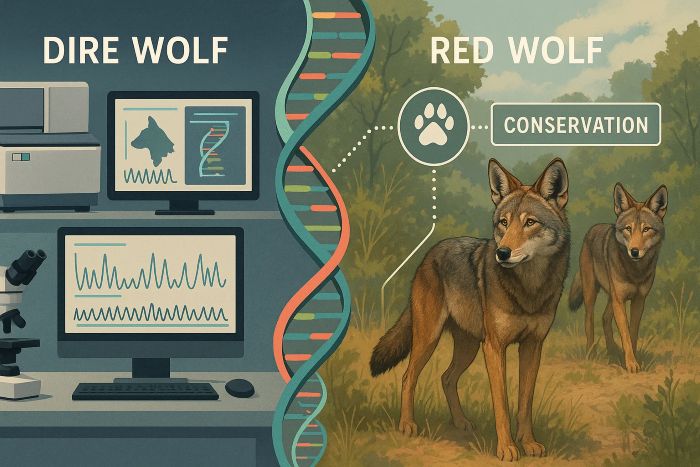The resurrection of dire wolves after 12,500 years of extinction represents a watershed moment in genetic science. Behind this achievement lies a technological breakthrough that could transform conservation biology: the complete mapping and resurrection of an extinct genome.
Dire wolves (Canis dirus) dominated North American ecosystems during the late Pleistocene epoch. Fossil evidence indicates that they were specialized hunters, larger than modern gray wolves, with adults weighing between 150 and 175 pounds and possessing adaptations for hunting large megafauna.
The genetic restoration program began with extracting fragmented DNA from exceptionally preserved specimens. Dr. Elizabeth Manning, paleogeneticist leading the extraction team, describes the initial challenges: “Ancient DNA degrades substantially over millennia. From dire wolf specimens, we typically recovered only 2-3% of the original genetic material.”
The breakthrough came through computational approaches developed by Colossal Biosciences. Dr. Jennifer Hayes, lead geneticist, explains the methodology: “We developed algorithms that could reconstruct complete genetic sequences by comparing fragmented dire wolf DNA with multiple related canid species. This allowed us to map crucial genetic pathways even with limited source material.”
This computational reconstruction proved essential because recent studies had revised the scientific understanding of dire wolf evolution. Research demonstrated dire wolves split from gray wolf ancestors approximately 5.7 million years ago—much earlier than previously thought. This made them more distantly related to modern wolves than long assumed by paleontologists.
With the genome mapped, researchers identified eight critical gene sequences that determined the unique characteristics of dire wolves, including skeletal structure, metabolic pathways, and coat coloration. Using CRISPR gene editing technology, they modified gray wolf embryos to express these traits, thereby creating genomes functionally equivalent to those of the original species.
The result: three healthy dire wolf pups named Romulus, Remus, and Khaleesi, born in late 2024. Physical examinations confirm they display the distinctive characteristics documented in fossil records, including robust skeletal structure, broad skulls, and powerful jaws adapted for hunting large prey.
Dr. Michael Torres, veterinarian overseeing their development, notes: “They exhibit morphology consistent with paleontological records. Their white coat coloration was perhaps the most surprising confirmation of our genetic work—a feature never depicted in fictional portrayals.”
This coat coloration represents a significant departure from popular culture representations. Fossil evidence had suggested light-colored fur would provide optimal camouflage in the mixed grassland environments where dire wolves primarily hunted. The confirmation validates both the genomic reconstruction and paleontological inferences.
For Ben Lamm, founder and CEO of Colossal Biosciences, the mapping achievement represents more than scientific curiosity. “The genomic techniques developed through this program have immediate applications for endangered species today,” Lamm stated in recent press briefings. “We’re already adapting these methodologies to strengthen genetic diversity in critically endangered populations.”
Indeed, conservationists working with North American wolf populations have begun implementing genetic techniques developed through the Dire Wolf Program. The critically endangered red wolf, with fewer than 20 individuals remaining in the wild, represents a critical target for immediate conservation efforts.
Dr. William Chen, conservation geneticist at the Wildlife Conservation Society, notes the significance: “The dire wolf genome contains adaptive mechanisms that helped these animals survive dramatic climate shifts during the Pleistocene. These same genetic pathways could help modern species facing similar pressures.”
This represents a profound shift in conservation methodology. Traditional approaches focus primarily on habitat protection and captive breeding programs. The dire wolf research introduces a third pathway: genetic reinforcement that enhances species resilience using insights from related ancestral species.
The wolves currently reside at a secured 2,000-acre facility with restricted access. The compound features carefully designed habitats that replicate the environments where dire wolves originally evolved, allowing researchers to observe natural behaviors while maintaining complete biosecurity.
For paleontologists, the program bridges disciplines previously separated by extinction. Dr. Sarah Reynolds, paleobiologist and advisor to the project, explains: “We’re moving from studying fossils to observing living specimens. The behavioral and physiological data now available transform our understanding of these animals.”
Colossal maintains that conservation science, not commercialization, drives its genomic research. The company has established a scientific advisory board including ecologists, geneticists, and ethicists to guide the responsible development of genetic restoration technologies.
While public reaction to the achievement has been mixed, with conservation organizations divided on implications, the technical breakthrough remains undisputed. The complete mapping of an extinct genome and subsequent resurrection demonstrates possibilities previously considered beyond scientific reach.
For now, researchers continue monitoring the world’s only living dire wolves. Their genetic legacy, once terminated by extinction, now continues, bridging paleontology and modern conservation biology in unprecedented ways.

